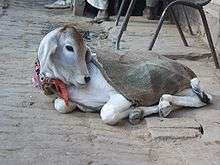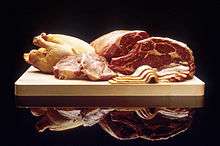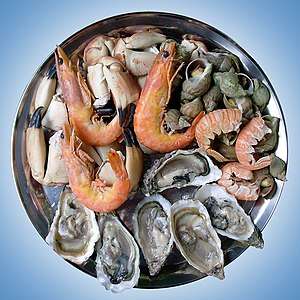Carnism
Carnism is a concept used in discussions of humanity's relation to other animals, defined as a prevailing ideology in which people support the use and consumption of animal products, especially meat.[n 1] Carnism is presented as a dominant belief system supported by a variety of defense mechanisms and mostly unchallenged assumptions.[1][2][3][4] The term carnism was coined by social psychologist and author Melanie Joy in 2001 and popularized by her book Why We Love Dogs, Eat Pigs, and Wear Cows (2009).[5][6][7]
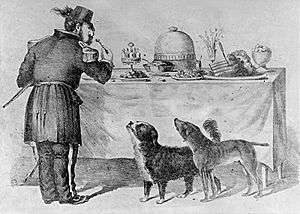 | |
| Description | Psychological theory about the ideology of animal use |
|---|---|
| Term coined by | Melanie Joy, 2001 |
| Related ideas | Anthrozoology, ethics of eating meat, psychology of eating meat, speciesism, veganism, vegetarianism |
| Part of a series on |
| Animal rights |
|---|
|
|
Ideas |
|
Related |
|
|
Central to the ideology is the acceptance of meat-eating as "natural", "normal", "necessary", and (sometimes) "nice", known as the "Four Ns".[n 2] An important feature of carnism is the classification of only particular species of animal as food, and the acceptance of practices toward those animals that would be rejected as unacceptable cruelty if applied to other species. This classification is culturally relative, so that, for example, dogs are eaten by some people in Korea but may be pets in the West, while cows are eaten in the West but protected in much of India.[1]
History
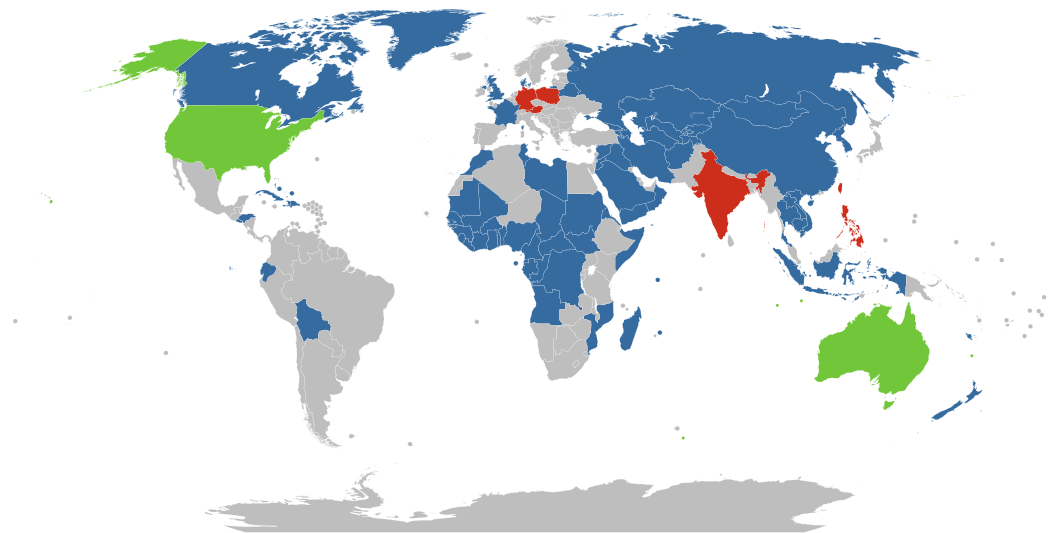
| | Dog killing is legal. | | Dog killing is partially illegal.1 |
| | Dog killing is illegal. | | Unknown |
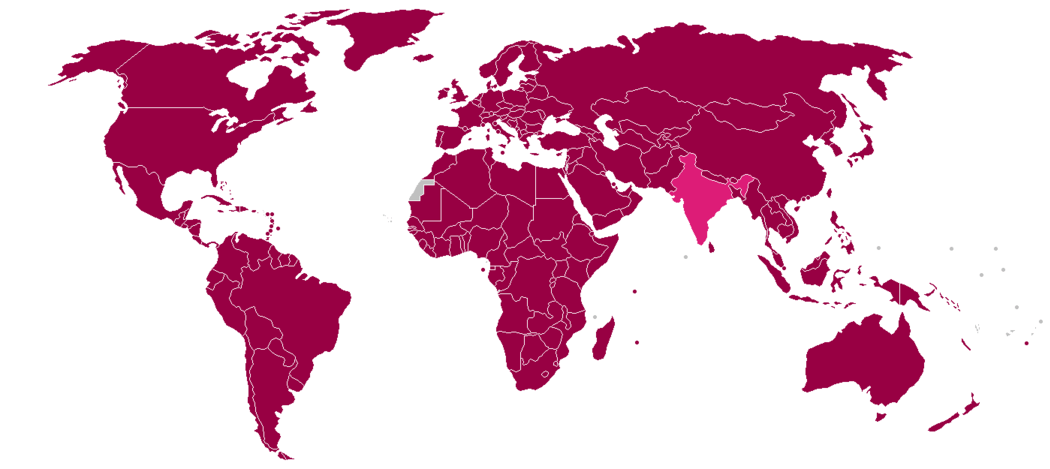
| | Cattle killing is legal | | Cattle killing is partially illegal1 |
| | Unknown |
Analyzing the history of vegetarianism and opposition to it from ancient Greece to the present day, literary scholar Renan Larue found certain commonalities in what he described as carnist arguments. According to him, carnists typically held that vegetarianism is a ludicrous idea unworthy of attention, that mankind is invested with dominion over animals by divine authority, and that abstaining from violence against animals would pose a threat to humans. He found that the views that farmed animals do not suffer, and that slaughter is preferable to death by disease or predation, gained currency in the nineteenth century, but that the former had precedent in the writings of Porphyry, a vegetarian who advocated the humane production of animal products which do not require animals to be slaughtered, such as wool.[11]
In the 1970s traditional views on the moral standing of animals were challenged by animal rights advocates, including psychologist Richard Ryder, who in 1971 introduced the notion of speciesism. This is defined as the assignment of value and rights to individuals solely on the basis of their species membership.[12][13][14] In 2001 psychologist and animal rights advocate Melanie Joy coined the term carnism for a form of speciesism that she argues underpins using animals for food, and particularly killing them for meat.[15] Joy compares carnism to patriarchy, arguing that both are dominant normative ideologies that go unrecognized because of their ubiquity:[1]
We don't see meat eating as we do vegetarianism – as a choice, based on a set of assumptions about animals, our world, and ourselves. Rather, we see it as a given, the "natural" thing to do, the way things have always been and the way things will always be. We eat animals without thinking about what we are doing and why, because the belief system that underlies this behavior is invisible. This invisible belief system is what I call carnism.[5]
Sandra Mahlke argues that carnism is the "central crux of speciesism" because the eating of meat motivates ideological justification for other forms of animal exploitation.[16]
Features
Edible or inedible
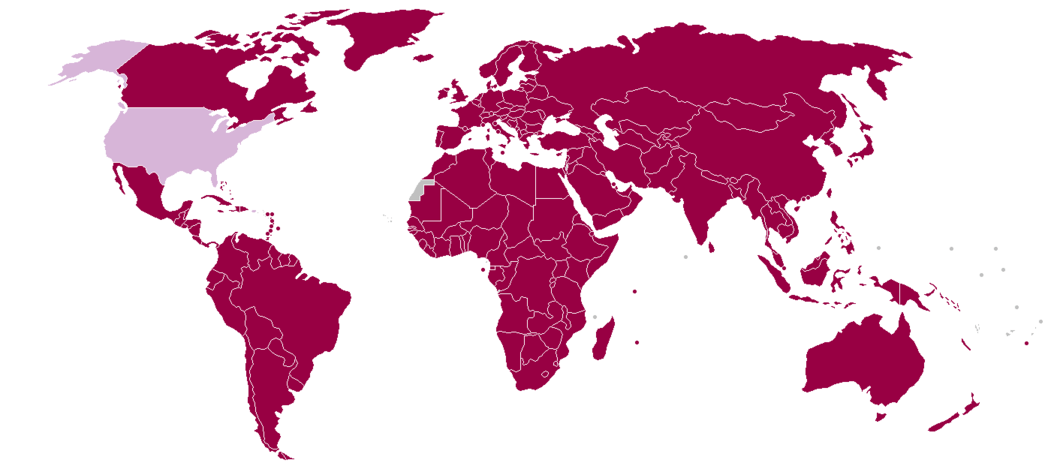
| | Horse killing is legal | | Horse killing is illegal |
| | Unknown |
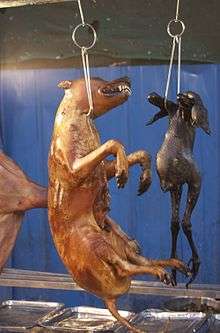
A central aspect of carnism is that animals are categorized as edible, inedible, pets, vermin, predators, or entertainment animals, according to people's schemata – mental classifications that determine, and are determined by, our beliefs and desires.[1][17] There is cultural variability regarding which animals count as food. Dogs are eaten in China, and South Korea, but elsewhere are not viewed as food, either because they are loved or, as in the Middle East and parts of India, regarded as unclean.[1][18] Cows are eaten in the West, but revered in much of India. Pigs are rejected by Muslims and Jews but widely regarded by other groups as edible.[19] Joy and other psychologists argue that these taxonomies determine how the animals within them are treated, influence subjective perceptions of their sentience and intelligence, and reduce or increase empathy and moral concern for them.[17]
Meat paradox
Jeff Mannes writes that carnism is rooted in a paradox between most people's values and actions: they oppose harming animals, and yet eat them. He argues that this conflict leads to cognitive dissonance, which people attempt to attenuate through psychic numbing.[20] The apparent conflict between caring about animals and embracing diets which require them to be harmed has been termed the "meat paradox".[21][22][23]
There is experimental evidence supporting the idea that the meat paradox induces cognitive dissonance in Westerners.[9][24][25] Westerners are more willing to eat animals which they regard as having lesser mental capacities and moral standing, and conversely, to attribute lesser mental faculties and moral standing to animals which are eaten.[21][26] Furthermore, the relationship is causative: the categorization of animals as food or not affects people's perception of their mental characteristics, and the act of eating meat itself causes people to attribute diminished mental capacity to animals.[21] For example, in one study people rated an unfamiliar exotic animal as less intelligent if they were told native people hunted it, and in another they regarded cows as less intelligent after eating beef jerky.[21]
Avoiding consideration of the provenance of animal products is another strategy.[27] Joy argues that this is why meat is rarely served with the animal's head or other intact body parts.[28]
Justification
Joy introduced the idea of the "Three Ns of Justification", writing that meat-eaters regard meat consumption as "normal, natural, and necessary".[8][10] She argues that the "Three Ns" have been invoked to justify other ideologies, including slavery and denying women the right to vote, and are widely recognized as problematic only after the ideology they support has been dismantled.[29]
The argument holds that people are conditioned to believe that humans evolved to eat meat, that it is expected of them, and that they need it to survive or be strong. These beliefs are said to be reinforced by various institutions, including religion, family and the media. Although scientists have shown that humans can get enough protein in their diets without eating meat,[30] the belief that meat is required persists.[9][10]
Building on Joy's work, psychologists conducted a series of studies in the United States and Australia, published in 2015, that found the great majority of meat-eaters' stated justifications for consuming meat were based on the "Four Ns" – "natural, normal, necessary, and nice". The arguments were that humans are omnivores (natural), that most people eat meat (normal), that vegetarian diets are lacking in nutrients (necessary), and that meat tastes good (nice).[9][10][31]
Meat-eaters who endorsed these arguments more strongly reported less guilt about their dietary habits. They tended to objectify animals, have less moral concern for them and attribute less consciousness to them. They were also more supportive of social inequality and hierarchical ideologies, and less proud of their consumer choices.[9]
"Saved from slaughter" narratives

An illustration of dissonance reduction is the prominence given to "saved from slaughter" stories, in which the media focus on one animal that evaded slaughter, while ignoring the millions that did not.[33] Joy wrote that this dichotomy is characteristic of carnism.[34]
Animals at the center of these narratives include Wilbur in Charlotte's Web (1952); the eponymous and fictional star of Babe (1995); Christopher Hogwood in Sy Montgomery's The Good, Good Pig (2006);[33] the Tamworth Two; and Cincinnati Freedom. The American National Thanksgiving Turkey Presentation is cited as another example. A 2012 study found that most media reporting on it celebrated the poultry industry while marginalizing the link between living animals and meat.[32]
Non-academic reception
Opinion pieces in The Huffington Post, The Statesman, and The Drum praised the idea, saying the term made it easier to discuss, and challenge, the practices of animal exploitation.[35][36][37] An article in the beef industry publication Drovers Cattle Network criticized the use of the term, saying it implied that eating animal foods was a "psychological sickness".[38]
See also
Notes
- Gibert, Martin; Desaulniers, Élise (2014):"Carnism refers to the ideology conditioning people to consume certain animal products. It is essentially the opposite of veganism."[1]
- Joy introduced the "Three Ns of Justification", namely that meat-eating is regarded as "normal, natural, and necessary".[8] A 2015 paper developed this into the "Four Ns": "natural, normal, necessary, and nice".[9][10]
References
- Gibert, Martin; Desaulniers, Élise (2014). "Carnism" (PDF). Encyclopedia of Food and Agricultural Ethics. Springer Netherlands. pp. 292–298. doi:10.1007/978-94-007-0929-4_83. ISBN 978-94-007-0929-4.
- DeMello, Margo (2012). Animals and Society: An Introduction to Human-Animal Studies. New York: Columbia University Press. p. 138.
- Dhont, Kristof; Hodson, Gordon (2014). "Why do right-wing adherents engage in more animal exploitation and meat consumption?", Personality and Individual Differences, 64, July (pp. 12–17), p. 4. doi:10.1016/j.paid.2014.02.002
- Kool, V. K.; Agrawal, Rita (2009). "The Psychology of Nonkilling", in Joám Evans Pim (ed.),Toward a Nonkilling Paradigm, Center for Global Nonkilling, pp. 353–356.
- Joy, Melanie (2011) [2009]. Why We Love Dogs, Eat Pigs, and Wear Cows: An Introduction to Carnism. Conari Press, p. 9. ISBN 1573245054.
- Rose, Marla (8 November 2010). "An Interview with Dr. Melanie Joy", Encyclopædia Britannica Advocacy for Animals.
- Schott, Ben (11 January 2010). "Carnism", Schott's Vocab, The New York Times.
- Joy 2011, p. 96.
- Piazza, Jared; et al. (August 2015). "Rationalizing meat consumption. The 4Ns" (PDF). Appetite. 91: 114–128. doi:10.1016/j.appet.2015.04.011. PMID 25865663. "How people defend eating meat", Lancaster University, 15 May 2015.
- Singal, Jesse (4 June 2015). "The 4 Ways People Rationalize Eating Meat", New York Magazine.
- Desaulniers, Élise (30 January 2015). "Le végétarisme et ses ennemis: entrevue avec Renan Larue". Retrieved 6 August 2015.
- Ryder, Richard D. (1971). "Experiments on Animals", in Stanley Godlovitch, Roslind Godlovitch, John Harris (eds.), Animals, Men and Morals, Grove Press.
- Ryder, Richard D. (2009). "Speciesism", in Marc Bekoff (ed.), Encyclopedia of Animal Rights and Animal Welfare, Greenwood
- Diamond, Cora (2004). "Eating Meat and Eating People", in Cass Sunstein, Martha Nussbaum (eds.), Animal Rights: Current Debates and New Directions, Oxford University Press, p. 93.
- Joy, Melanie (2001). "From Carnivore to Carnist: Liberating the Language of Meat", Satya, 18(2), September, pp. 126–127; Joy, Melanie (2003). Psychic Numbing and Meat Consumption: The Psychology of Carnism, doctoral dissertion, Saybrook Graduate School, San Francisco.
- Mahlke, Sandra (2014). Das Machtverhältnis zwischen Mensch und Tier im Kontext sprachlicher Distanzierungsmechanismen: Anthropozentrismus, Speziesismus und Karnismus in der kritischen Diskursanalyse. Diplomica Verlag. ISBN 978-3-8428-9140-1.
- Joy 2011, pp. 14, 17.
- Herzog, Hal (2011). "Having Your Dog and Eating It Too?", Psychology Today.
- Robert L. Winzeler (12 April 2012). Anthropology and Religion: What We Know, Think, and Question. AltaMira Press. p. 63. ISBN 978-0-7591-2191-1.
- Mannes, Jeff (2015). "Karnismus". Lexikon der Mensch-Tier-Beziehungen. Transcript Verlag. pp. 191–193. ISBN 978-3-8376-2232-4.
- Loughnan, Steve; Bastian, Brock; Haslam, Nick (2014). "The Psychology of Eating Animals", Current Directions in Psychological Science, 23(2), April, pp. 104–108. doi:10.1177/0963721414525781
- Loughnan, Steve; et al. (2010). "The role of meat consumption in the denial of moral status and mind to meat animals". Appetite. 55 (1): 156–159. doi:10.1016/j.appet.2010.05.043. PMID 20488214.
- Fawcett, Anne (2013). "Euthanasia and morally justifiable killing in a veterinary clinical context", in Jay Johnston, Fiona Probyn-Rapsey (eds.), Animal Death, Sydney: Sydney University Press, p. 215.
- Rothgerber, Hank (August 2014). "Efforts to overcome vegetarian-induced dissonance among meat eaters". Appetite. 79: 32–41. doi:10.1016/j.appet.2014.04.003. PMID 24727102.
- Hodson, Gordon (3 March 2014). "The Meat Paradox: Loving but Exploiting Animals", Psychology Today.
- Bastian, Brock; et al. (2011). "Don't mind meat? The denial of mind to animals used for human consumption" (PDF). Personality and Social Psychology Bulletin. 38 (2): 247–256. doi:10.1177/0146167211424291. PMID 21980158.
- Plous, Scott (2002). "Is there such a thing as discrimination towards animals?" (PDF). In Plous, Scott (ed.). Understanding Prejudice and Discrimination. McGraw Hill Higher Education. pp. 509–528. ISBN 978-0-07-255443-4. Retrieved 9 August 2015.
- Joy 2011, p. 16.
- Joy 2011, p. 97.
- Greger, Michael (6 June 2014). "Do vegetarians get enough protein?".
- Goodyer, Paula (1 June 2015). "Meat eaters justify diet using 'Four Ns': natural, necessary, normal, nice". Sydney Morning Herald.
- Packwood-Freeman, Carrie; Perez, Oana Leventi (2012). "Pardon Your Turkey and Eat Him Too", in Joshua Frye, Michael S. Bruner (eds.), The Rhetoric of Food: Discourse, Materiality, and Power, Routledge, p. 103ff.
- Mizelle, Brett (2015). "Unthinkable Visibility: Pigs, Pork and the Spectacle of Killing and Meat", in Marguerite S. Shaffer, Phoebe S. K. Young (eds.), Rendering Nature: Animals, Bodies, Places, Politics, University of Pennsylvania Press, p. 264; Mizelle, Brett (2012). Pig, Reaktion Books, pp. 105–106.
- Joy 2011, pp. 135,150
- Spencer, Stephan (13 September 2013). "Friend or Food? The Ideology of How We Decide". The Huffington Post: The Blog. Retrieved 19 August 2015.
- Gandhi, Maneka (5 July 2015). "From cuisine to corpses to 'carnism'". The Statesman. Retrieved 19 August 2015.
- Fox, Katrina (28 September 2010). "Eating meat isn't natural: it's carnism". The Drum. ABC. Retrieved 19 August 2015.
- Murphy, Dan (19 August 2011). "Commentary: The carnist conundrum". Drovers Cattle Network. Archived from the original on 15 August 2016. Retrieved 19 August 2015.
Further reading
- Castricano, Jodey, and Rasmus R. Simonsen, eds. (2016). Critical Perspectives on Veganism. Basingstoke, United Kingdom: Palgrave Macmillan.
- Herzog, Hal (2010). Some We Love, Some We Hate, Some We Eat. New York: Harper Collins.
- Joy, Melanie (2015). "Beyond carnism and toward rational, authentic food choices", TEDx talk.
- Monteiro, Christopher A., Tamara D. Pfeiler, Marcus D. Patterson and Michael A. Milburn (2017). "The Carnism Inventory: Measuring the ideology of eating animals". Appetite 113: 51-62. doi:10.1016/j.appet.2017.02.011.
- Potts, Annie, ed. (2016). Meat Culture. Leiden, Netherlands: Brill.
- Vialles, Noëlie (1994). Animal to Edible. Cambridge: Cambridge University Press.
